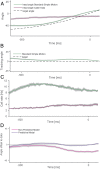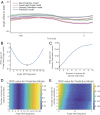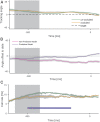Echolocating bats accumulate information from acoustic snapshots to predict auditory object motion
- PMID: 33139550
- PMCID: PMC7682551
- DOI: 10.1073/pnas.2011719117
Echolocating bats accumulate information from acoustic snapshots to predict auditory object motion
Abstract
Unlike other predators that use vision as their primary sensory system, bats compute the three-dimensional (3D) position of flying insects from discrete echo snapshots, which raises questions about the strategies they employ to track and intercept erratically moving prey from interrupted sensory information. Here, we devised an ethologically inspired behavioral paradigm to directly test the hypothesis that echolocating bats build internal prediction models from dynamic acoustic stimuli to anticipate the future location of moving auditory targets. We quantified the direction of the bat's head/sonar beam aim and echolocation call rate as it tracked a target that moved across its sonar field and applied mathematical models to differentiate between nonpredictive and predictive tracking behaviors. We discovered that big brown bats accumulate information across echo sequences to anticipate an auditory target's future position. Further, when a moving target is hidden from view by an occluder during a portion of its trajectory, the bat continues to track its position using an internal model of the target's motion path. Our findings also reveal that the bat increases sonar call rate when its prediction of target trajectory is violated by a sudden change in target velocity. This shows that the bat rapidly adapts its sonar behavior to update internal models of auditory target trajectories, which would enable tracking of evasive prey. Collectively, these results demonstrate that the echolocating big brown bat integrates acoustic snapshots over time to build prediction models of a moving auditory target's trajectory and enable prey capture under conditions of uncertainty.
Keywords: Eptesicus fuscus; auditory localization; biosonar; predictive models; prey tracking.
Conflict of interest statement
The authors declare no competing interest.
Figures





Similar articles
-
Sonar tracking of horizontally moving targets by the big brown bat Eptesicus fuscus.Science. 1985 Jun 14;228(4705):1331-3. doi: 10.1126/science.4001947. Science. 1985. PMID: 4001947
-
Natural echolocation sequences evoke echo-delay selectivity in the auditory midbrain of the FM bat, Eptesicus fuscus.J Neurophysiol. 2018 Sep 1;120(3):1323-1339. doi: 10.1152/jn.00160.2018. Epub 2018 Jun 20. J Neurophysiol. 2018. PMID: 29924708
-
Echolocating bats use a nearly time-optimal strategy to intercept prey.PLoS Biol. 2006 May;4(5):e108. doi: 10.1371/journal.pbio.0040108. Epub 2006 Apr 18. PLoS Biol. 2006. PMID: 16605303 Free PMC article.
-
A view of the world through the bat's ear: the formation of acoustic images in echolocation.Cognition. 1989 Nov;33(1-2):155-99. doi: 10.1016/0010-0277(89)90009-7. Cognition. 1989. PMID: 2691182 Review.
-
Representation of perceptual dimensions of insect prey during terminal pursuit by echolocating bats.Biol Bull. 1996 Aug;191(1):109-21. doi: 10.2307/1543071. Biol Bull. 1996. PMID: 8776847 Review.
Cited by
-
Echolocating toothed whales use ultra-fast echo-kinetic responses to track evasive prey.Elife. 2021 Oct 26;10:e68825. doi: 10.7554/eLife.68825. Elife. 2021. PMID: 34696826 Free PMC article.
-
SonoNERFs: Neural Radiance Fields Applied to Biological Echolocation Systems Allow 3D Scene Reconstruction through Perceptual Prediction.Biomimetics (Basel). 2024 May 28;9(6):321. doi: 10.3390/biomimetics9060321. Biomimetics (Basel). 2024. PMID: 38921202 Free PMC article.
-
Sensory error drives fine motor adjustment.Proc Natl Acad Sci U S A. 2022 Jul 5;119(27):e2201275119. doi: 10.1073/pnas.2201275119. Epub 2022 Jun 27. Proc Natl Acad Sci U S A. 2022. PMID: 35759672 Free PMC article.
-
Bat target tracking strategies for prey interception.Commun Integr Biol. 2021 Mar 12;14(1):37-40. doi: 10.1080/19420889.2021.1898751. Commun Integr Biol. 2021. PMID: 33796208 Free PMC article.
-
Spatial attention in natural tasks [version 1; peer review: 2 approved with reservations].Mol Psychol. 2022;1:4. doi: 10.12688/molpsychol.17488.1. Epub 2022 Dec 22. Mol Psychol. 2022. PMID: 37325441 Free PMC article.
References
-
- Visioneers , The Science of SonarVision (2019). https://visioneers.org/what-we-do/the-science-of-sonarvision/. Accessed 4 May 2020.
-
- Griffin D. R., Listening in the Dark: The Acoustic Orientation of Bats and Men (Yale University Press, 1958).
-
- Simmons J. A., Fenton M. B., O’Farrell M. J., Echolocation and pursuit of prey by bats. Science 203, 16–21 (1979). - PubMed
Publication types
MeSH terms
LinkOut - more resources
Full Text Sources
Miscellaneous

